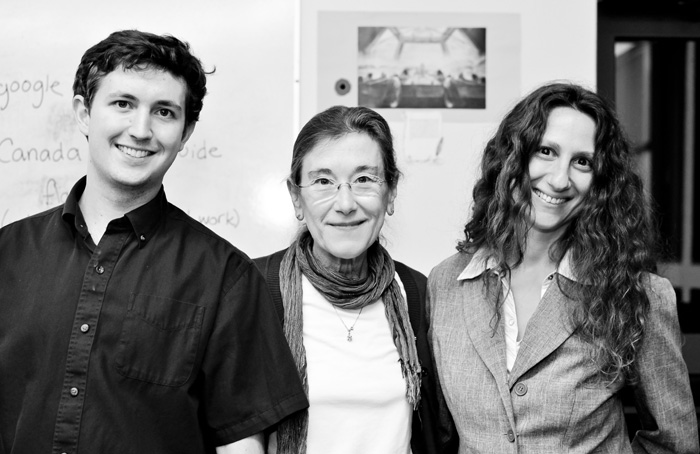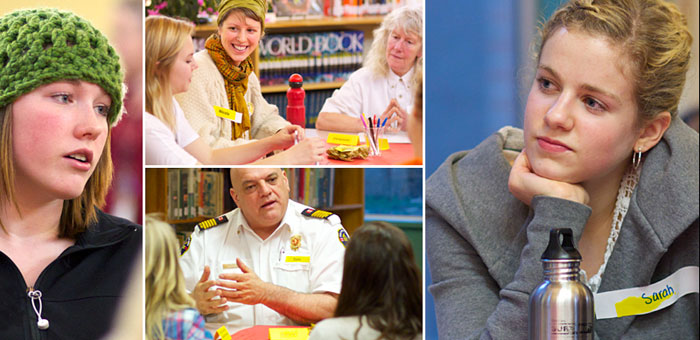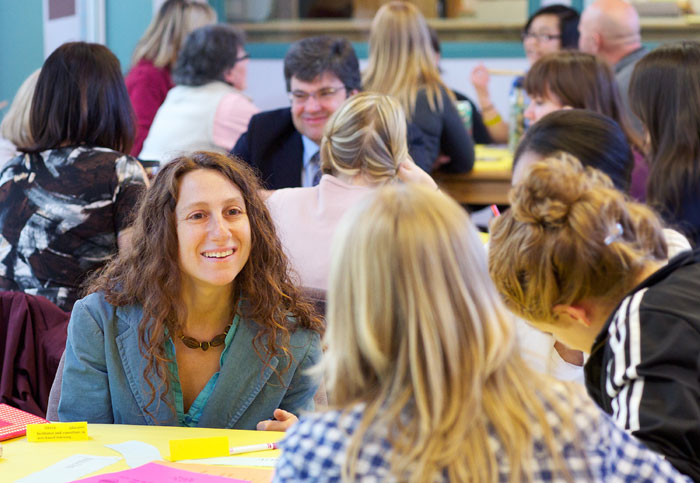District: No. 64 (Gulf Islands)
On Salt Spring Island, the Connecting Generations project continues to expand and redefine itself in response to the new opportunities it creates for students, educators and their community. Continuing is building bridges between generations through dialogue, intergenerational learning and relationship building.
New project videos: Surrendering to Spontaneity and Weaving a Mentorship: Room to Play and Stretch (More Growing Innovation videos)
For the project’s web site, click HERE.
Find a Growing Innovation-produced video about this project HERE
An article by project facilitator Dr. Ahava Shira: (The Bridge: An Intergenerational Space for Learning) may be found among the articles at Community Works Journal HERE.
For an item on this project in a local paper, click HERE.
For an evaluation of the “Bridging the Gap” initiative, Connecting Generations’ component of community fora, click HERE and for that of the “Building the Bridge” project (which involved an intergenerational team who created the program website and brochure) click HERE.
The project report to the Growing Innovation Symposium (PDF) may be found HERE.
Here are some project related pictures –
On Salt Spring Island, the Connecting Generations team of Scott Chamney, Sarah Hook-Nilsson and Ahava Shira:

Part of the “blurring the boundaries” work of the Connecting Generations project consists in periodic, variously themed, public fora, remarkable events which form an important part of the project’s inquiries.


Hamish and a student:

(With thanks to Sarah Hook Nilsson for the images).
Webinar resources from this project’s 2013 Growing Innovation webinar are available here –
1. November 26, 2012 – Project Based Learning for Student Engagement in SD#59 (Peace River South) and SD#60 (Peace River North)
Powerpoint presentations from this webinar are available for download in two parts (of ~20MB each), to download part 1, click HERE, and for part 2, click HERE.
2. January 15, 2013 – Place Conscious Learning through Digital Story Telling in SD#8 (Kootenay Lake) and SD#10 (Arrow Lakes).
The powerpoint presentation (10 MB) from this webinar is available for download HERE.
A PDF file of the part of the presentation from Digital Heritage Connect Project Leader Tamara Malloff may be found HERE.
3. January 17, 2013 – Nature Kindergarten in SD#62 (Sooke)
The powerpoint presentation (23 MB) from this webinar is available for download HERE.
4. February 21, 2013 – Connected Classrooms and Collaboration without Boundaries in SD#74 (Gold Trail) and SD#85 (Vancouver Island North)
The powerpoint presentation (10 MB) from this webinar is available for download HERE.
5. March 5, 2013 – The Aboriginal Academy in SD#58 (Nicola-Similkameen).
For a video from this project, click HERE.
A recording of the webinar is now available to be viewed HERE.
6. April 11, 2013 – Connecting Generations in SD#64 (Gulf Islands).
The powerpoint presentation (60MB) from this webinar is available for download HERE.
To download the Experiential Learning Consent & Waiver form Sarah & Ahava described, click HERE.
A recording of the webinar is now available to be viewed HERE
7. April 29, 2013 – Transitioning Students with Special Needs through Community Partnerships in SD#51 (Boundary).
The powerpoint presentation from this webinar is available for download HERE.
A recording of the webinar is now available to be viewed HERE.\
Feedback from “Abracadabra” – a forum about creativity at Salt Spring Island Middle School is collected in a handsome PDF HERE.
Connecting Generations November/December 2014 UPDATE.
Connecting Generations November 2015 UPDATE.
The stream that is Connecting Generations has many currents, including now a wonderful and growing collection of video documentation, most recently with “Creating a Safe Space – Gulf Islands Secondary School Writers’ Group,” a powerful testament to transformative culture in education. We hope you appreciate this work as much as we do, and can find in it inspiration to document your collective efforts in generating curriculum, community and new forms of life.
Continuing to evolve in 2018, this year Connecting Generations has found a new vector called “Writing Ourselves Homewards”
In this CG incarnation, Sarah Hook-Nilsson and Ahava Shira will develop WOH to bring the Home Words project presently happening on Salt Spring, to Windsor House School in North Vancouver which is a part of SD 64 (Gulf Islands). Through the delivery of a half day workshop for a group of up to 15 students and teachers and/or community members at one of the locations where Windsor House is currently based, we will explore what “Home” means through the 4 step practice of Writing Alone Together: Writing Freely, Reading aloud, Listening Deeply and Bearing Witness. The benefits of this project will be that it will give us the opportunity:
- to test our rural based project in an urban environment, (without leaving the school district!)
- to witness how the 4 writing practices which we have used for 6 years on Salt Spring are applicable in a different culture
- to provide Windsor House School with a further opportunity to look at their own homelessness from another perspective and, we hope,
- to inspire adults and youth alike at Windsor House to continue this very valuable habit of “Writing Alone Together”
And finally (for now) don’t miss the November 2017 Connecting Generations Update.
